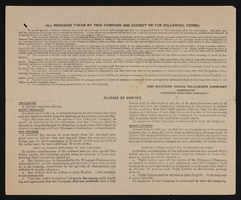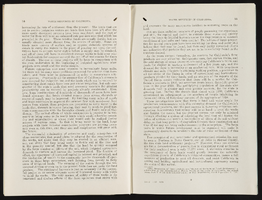Search the Special Collections and Archives Portal
Search Results
Sondra Cosgrove (Vote Nevada) oral history interview conducted by Magalena Martinez and Elia Del Carmen Solano-Patricio: transcript
Date
Archival Collection
Description
From the Lincy Institute "Perspectives from the COVID-19 Pandemic" Oral History Project (MS-01178) -- Community organization interviews file.
Text
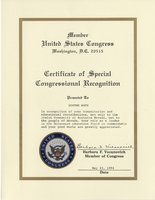
Keith Boman Papers on the Smith Center for the Performing Arts
Identifier
Abstract
The Keith Boman Papers on the Smith Center for the Performing Arts consist of materials documenting the construction of the Smith Center for the Performing Arts in Las Vegas, Nevada from approximately 2009 to 2010. The collection includes documents from the construction oversight committee, financial budgets, and board of directors meeting agendas.
Archival Collection
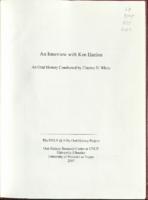
Transcript of interview with Ken Hanlon by Claytee D. White, November 29, 2006
Date
Archival Collection
Description
Text
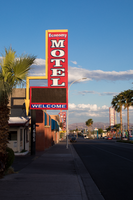
Photographs of Economy Motel sign, Las Vegas (Nev.), April 18, 2017
Date
Archival Collection
Description
Site address: 1605 Fremont St
Sign owner: Las Vegas Dragon Hotel LLC
Sign details: This building was constructed in 1953 for commercial living and motels and has been used for this since. This location was recently remodeled in 2016. The property previous to the Economy Motel was the Rangler Motel.
Sign condition: 5-looks newly restored
Sign form: Blade
Sign-specific description: The top of the sign is a red rectangular blade with the word "ECONOMY" in white skeletal neon tubes spelt out horizontally. Below the word Economy is the word "MOTEL" spelt out Vertically in channeled white letters with a blue border. Underneath this portion of the sign is a sign box where they have a plastic rectangular sign with their phone number on it. Under the sign box is "WELCOME" painted on the west side of the sign and "BIENVENDIO" on the east side. On the building side of the side box is a rectangular yellow arrow pointing down to the lobby of the motel.
Sign - type of display: Neon and plastic backlit sign
Sign - media: Steel and plastic
Sign - non-neon treatments: Plastic backlit sign
Sign environment: This location is on the East side of Fremont Street located close to many other motels some closed and some still open.
Sign - date of installation: Sign has been up but in a different form since at least 2007
Sign - date of redesign/move: Late 2016/ early 2017 repainted/ restored since it previously said Rangler Motel on the sign (had a plastic cover saying economy over that previous logo for a few years)
Sign - thematic influences: The arrow portion of this sign is a popular 1950's/60's motel sign theme.
Sign - artistic significance: It is a trend down on Fremont to take an old Motel sign and renovate it into the new motel's name and logo.
Survey - research locations: Owner's website http://www.1dragonhotel.com/about_us , assessor's map, Google map satellite view
Survey - research notes: The previous sign for the Rangler motel was repurposed for the Economy Motel, so the same MOTEL blade portion had the same font but channeled neon was added, as well as repainted.
Surveyor: Emily Fellmer
Survey - date completed: 2017-09-10
Sign keywords: Neon; Plastic; Steel; Pole sign; Electronic Message Center
Mixed Content
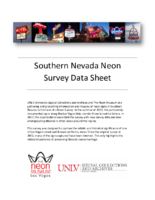
Fishers Inn Motel Neon Survey document, September 16, 2017
Date
Archival Collection
Description
Site address: 3565 Boulder Hwy
Sign owner: Maiya LLC
Sign details: The construction of the motel was in 1963. This location was previously the Comet Motel but the Fisher's bought it in 1987 and changed the name to Fisher's Inn Motel.
Sign condition: 5 - received new paint in 2017
Sign form: Raised roadside sign
Sign-specific description: This sign has a thin white steel beam base with plastic backlit sign that currently advertises ESPN, HBO, Over 150 channels and Free Wifi. Above the reader board is a rectangular (but has a curved portion to the top of it) blue sign that states "FI" on top in a cursive font, underneath in a block white font states "A Fisher's Inn". Underneath "A Fisher's Inn" there is are big yellow "MOTEL" block font letters with a simple "No Vacancy" skeletal neon beneath it. At night the "FI" illuminates yellow, "A Fisher's Inn" green, " MOTEL" red, "NO VACANCY" is blue, but on the top portion of the sign there is white skeletal neon in the shape of possibly a Fisherman's hat.
Sign - type of display: Neon and backlit plastic sign
Sign - media: Steel and plastic
Sign - non-neon treatments: Backlit plastic sign
Sign environment: This motel is on Boulder Highway, close to the 515 and is near other motels and car sales lots.
Sign - date of installation: c. 1987
Sign - date of redesign/move: 2017 painted blue when it used to be green
Sign - artistic significance: There's a good use of multiple colors on this sign. As well as repurposing older signs from previous property has been a major trend for signs in Vegas. Good example of skeletal neon.
Survey - research locations: Assessor's website
Survey - research notes: Bookings website gives hotel info https://www.booking.com/hotel/us/a-fishers- inn-motel.html
Surveyor: Emily Fellmer
Survey - date completed: 2017-09-16
Sign keywords: Neon; Backlit; Plastic; Steel; Roadside
Text
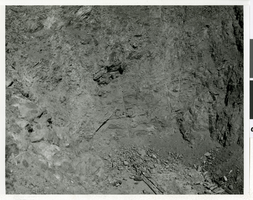
Photograph of the "Mole" Jarva Tunnel Borer at work on the Las Vegas River Mountain Project, Las Vegas, Nevada, circa 1968-1971
Date
Archival Collection
Description
Image
Audio recording clip of interview with Faye Todd by Claytee D. White, October 15, 1996
Date
Archival Collection
Description
Part of an interview with Faye Todd by Claytee White on October 15, 1996. Todd discusses how she came to work for the Landmark and what it was like to work with entertainers.
Sound

